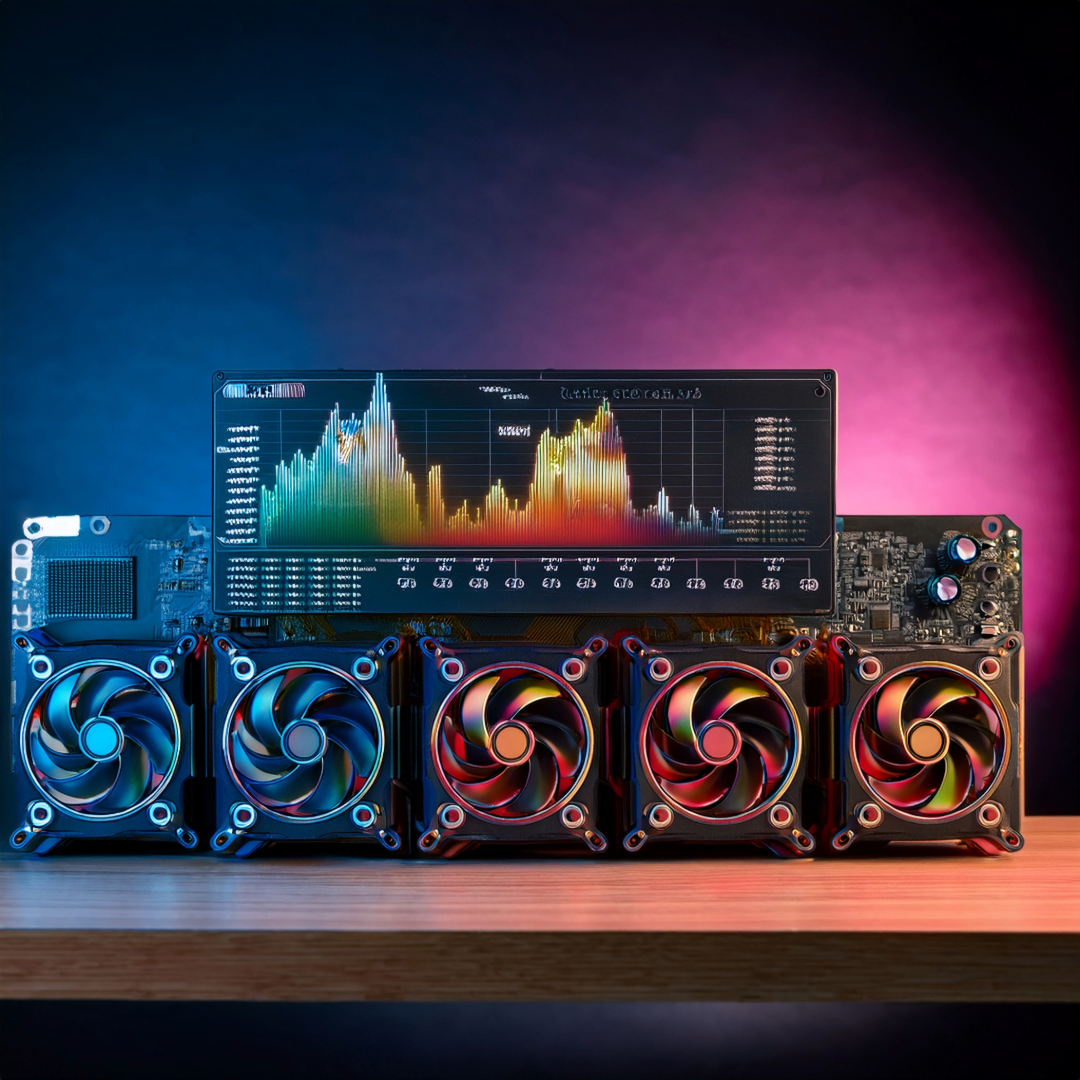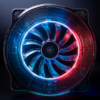Demystifying Ray Tracing: Best GPUs for Realistic Lighting Without Breaking the Bank (April 2025)
Ray tracing. It’s the buzzword that’s dominated graphics technology discussions for years, promising unparalleled realism in game visuals. From the subtle glint of light on wet pavement to the intricate dance of shadows in a dimly lit room, ray tracing aims to simulate light as it behaves in the real world, creating more immersive and believable digital environments. But this visual fidelity comes at a cost – a significant performance hit that often requires powerful, expensive hardware.
However, the landscape is changing. As of April 2025, advancements in GPU architecture and the maturation of AI-powered upscaling technologies like Nvidia’s DLSS and AMD’s FSR have made playable ray-traced experiences more accessible than ever. You no longer necessarily need a top-of-the-line behemoth to enjoy realistic lighting effects.
This guide dives into the world of affordable ray tracing. We’ll explain what ray tracing is, why it impacts performance, define what “affordable” means in the current GPU market, and most importantly, identify and rank the top 5 graphics cards that deliver the best ray tracing experience without requiring you to take out a second mortgage. Whether you’re building a new PC or upgrading an existing one, this guide will help you navigate the options and find the sweet spot for realistic visuals on a budget.
What is Ray Tracing (and Why the Performance Hit)?
At its core, ray tracing is a rendering technique that simulates the physical behavior of light. Traditional rendering methods, known as rasterization, are very efficient at drawing 3D scenes onto a 2D screen but often rely on clever tricks and approximations to simulate lighting effects like shadows and reflections. These methods can look good, but they often break down under scrutiny, leading to unrealistic light bleed, inaccurate reflections, or shadows that don’t quite behave naturally.
Ray tracing takes a different approach. Instead of approximating, it calculates the path of individual light rays as they travel from a light source, bounce off surfaces, refract through transparent materials, and eventually reach the virtual “camera” or viewpoint. By simulating these interactions – reflection, refraction, absorption – ray tracing can produce incredibly lifelike results, particularly for :
- Reflections: Surfaces like water, glass, or polished metal reflect their surroundings accurately, showing objects even outside the player’s direct view.
- Shadows: Shadows become softer and more realistic, accurately depicting how light sources are partially or fully occluded by objects.
- Global Illumination (Indirect Lighting): Light bounces realistically off surfaces, illuminating areas not directly lit by a light source, creating more natural and cohesive environments.
The catch? Simulating potentially billions of light rays and their complex interactions in real-time is immensely computationally demanding. Each ray needs to be tested for intersection with objects in the scene, its interaction calculated, and potentially new rays spawned for bounces or refractions. This massive workload is why enabling ray tracing typically results in a significant drop in frame rates (FPS) compared to traditional rasterization.
To counteract this performance cost, especially on non-flagship hardware, technologies like Nvidia’s Deep Learning Super Sampling (DLSS) and AMD’s FidelityFX Super Resolution (FSR) are essential. These upscaling techniques render the game at a lower internal resolution and then use sophisticated algorithms (often AI-powered) to intelligently reconstruct the image to your target resolution (e.g., 1080p or 1440p), reclaiming much of the lost performance while aiming to maintain high image quality. For affordable ray tracing, using DLSS or FSR isn’t just an option; it’s practically a necessity for a smooth, playable experience.
Defining “Affordable” Ray Tracing in April 2025
The term “affordable” in the GPU market is notoriously fluid, heavily influenced by supply, demand, manufacturing costs, and unfortunately, external factors like tariffs and scalping. What was considered mid-range yesterday might be budget today, and launch MSRPs often become distant memories mere weeks after release.
For this guide, as of April 2025, we’re defining “affordable” ray tracing GPUs as those typically available on the street market for under $650 USD. This price point aims to capture the upper-mid-range segment, where gamers can reasonably expect solid 1080p and increasingly viable 1440p performance with ray tracing enabled, provided they leverage appropriate upscaling technologies (DLSS/FSR).
While flagship cards like the Nvidia RTX 5090 or 5080 offer the absolute best ray tracing performance, their eye-watering prices (often exceeding $1400-$2000, sometimes much higher due to market conditions) place them firmly outside the “affordable” category for most builders. Our focus is on maximizing the ray tracing value – the best visual experience and playable frame rates for the money spent within our defined budget. This involves analyzing not just raw FPS, but FPS per dollar, factoring in current street prices which can deviate significantly from MSRP.
The Contenders: Nvidia vs. AMD (vs. Intel?)
In the sub-$650 arena for ray tracing in April 2025, the primary battleground features cards from Nvidia’s RTX 50-series (Blackwell) and AMD’s RX 9000-series (RDNA 4). We also need to consider potentially relevant previous-generation cards if their prices have dropped sufficiently, and Intel’s second-generation Arc Battlemage GPUs as budget contenders.
Nvidia (RTX 50-Series & 40-Series): Nvidia has historically held the advantage in ray tracing performance, and their Blackwell architecture (RTX 50-series) continues this trend, featuring 4th-gen RT cores and enhanced AI capabilities for DLSS 4. Key contenders in or near our price bracket include:
- GeForce RTX 5070: Launched with an MSRP of $549, this card aims for the mid-range sweet spot. It utilizes the GB205 GPU. However, it comes with 12GB of GDDR7 memory on a 192-bit bus, which raises concerns about future-proofing, especially at 1440p with heavy RT. Street prices have often hovered above MSRP.
- GeForce RTX 5060 Ti (16GB): Rumored and potentially launched around April 16th, 2025, this card is particularly interesting due to its 16GB VRAM option, addressing the 5070’s main weakness. Built on the GB206 chip with potentially 4608 CUDA cores and a 128-bit bus, its performance is expected to be lower than the 5070, but the extra VRAM and a potentially lower price point (rumored $429 MSRP for the 16GB version) make it highly relevant.
- GeForce RTX 4070 Super: A previous-generation card. While strong, its relevance in April 2025 depends heavily on significant price drops below its $599 launch MSRP, as newer cards offer better features like DLSS 4.
AMD (RX 9000-Series & 7000-Series): AMD’s RDNA 4 architecture (RX 9000-series) brought significant improvements, particularly in ray tracing and AI acceleration, aiming to close the gap with Nvidia. Key contenders include:
- Radeon RX 9070 XT: Launched at $599 MSRP, this card features the Navi 48 GPU with 64 Compute Units (CUs), 64 Ray Accelerators, 128 AI Accelerators, and 16GB of GDDR6 memory on a 256-bit bus. It offers strong rasterization performance, often trading blows with the more expensive RTX 5070 Ti, and boasts massively improved RT performance over RDNA 3, alongside the new ML-powered FSR 4. Street prices have been inflated, often well above MSRP.
- Radeon RX 9070: Launched at $549 MSRP, this uses a slightly cut-down Navi 48 die (56 CUs) but retains the 16GB/256-bit memory configuration. It offers solid performance, competing closely with the RTX 5070, and benefits from the RDNA 4 RT and FSR 4 improvements. Street prices have also been higher than MSRP.
- Radeon RX 7800 XT: A previous-generation card ($499 MSRP). While offering good rasterization performance for its price, its RDNA 3 ray tracing capabilities are significantly weaker than RDNA 4 or Nvidia’s offerings, making it less ideal for a dedicated RT build unless found at a very deep discount.
Intel (Arc B-Series): Intel’s second-generation Battlemage GPUs aimed to improve on their Alchemist predecessors, particularly in driver maturity and performance consistency.
- Arc B580: Launched at an attractive $249 MSRP, this card features 12GB of VRAM and surprisingly competent ray tracing performance for its price class, often punching above its weight against lower-end AMD cards and even challenging the RTX 4060 in some RT scenarios. However, potential CPU overhead issues on older systems and less mature/widespread XeSS upscaling compared to DLSS/FSR are factors to consider. Street prices have also crept up, often sitting around $340-$350.
These contenders form the basis of our analysis, focusing on their ability to deliver playable ray-traced experiences at 1080p and 1440p within the sub-$650 street price target.
Ray Tracing Performance Analysis (1080p & 1440p)
Evaluating ray tracing performance requires looking beyond simple FPS numbers in rasterized scenarios. The real test is how these GPUs handle demanding titles with ray tracing effects enabled, crucially with their respective upscaling technologies activated, as this reflects the most practical way to achieve playable frame rates on non-flagship hardware. Our analysis focuses on performance at 1080p and 1440p resolutions, using “High” or “Ultra” ray tracing presets where available, combined with “Quality” or “Balanced” upscaling settings (DLSS 4 for Nvidia RTX 50-series, FSR 4 for AMD RX 9000-series, XeSS for Intel Arc). Key benchmark games include demanding titles with significant RT implementations like Cyberpunk 2077, Alan Wake 2, Dying Light 2, and others representative of modern RT workloads.
Benchmark Breakdown:
- AMD RX 9070 XT ($599 MSRP / ~$850 Street): RDNA 4 shows its strength here. The 9070 XT delivers significantly improved RT performance compared to the previous generation RX 7900 XTX, often exceeding it despite having fewer CUs overall. It trades blows with the more expensive RTX 5070 Ti in many titles, sometimes winning in less RT-heavy scenarios but generally falling slightly behind in heavily path-traced games like Cyberpunk 2077 RT Ultra/Overdrive or Alan Wake 2 with Path Tracing. With FSR 4 Quality/Balanced at 1440p, it typically achieves playable frame rates (often 60+ FPS) in demanding RT titles, making it a strong 1440p RT contender. In Cyberpunk 2077 RT Ultra at 1440p, it might hover closer to the 60 FPS mark with FSR 4, while the 5070 Ti pushes slightly higher.
- Nvidia RTX 5070 ($549 MSRP / ~$600-700 Street): Blackwell continues Nvidia’s RT dominance in the mid-range. The RTX 5070 generally outperforms the RX 9070 in heavy ray tracing scenarios, though the gap has narrowed compared to previous generations. Its performance with DLSS 4 Quality/Balanced at 1440p is typically smooth, often exceeding 60 FPS in titles like Cyberpunk 2077 RT Ultra. However, its 12GB VRAM buffer can become a limitation in some titles at 1440p with high textures and RT enabled, potentially causing stutters or requiring lower texture settings compared to 16GB cards.
- AMD RX 9070 ($549 MSRP / ~$670 Street): Offering most of the RDNA 4 improvements at a lower price than the XT, the RX 9070 is a direct competitor to the RTX 5070. In ray tracing, it performs slightly below the RTX 5070 on average but remains very competitive, especially considering its 16GB VRAM advantage. It provides a solid 1080p RT experience and capable 1440p RT performance with FSR 4, often achieving frame rates close to the RTX 5070.
- Nvidia RTX 5060 Ti (16GB) ($429 MSRP / ~$450-500 Street): This card presents a compelling budget-conscious option for Nvidia fans wanting ample VRAM. Its RT performance is expected to be lower than the RTX 5070 due to fewer cores (likely 4608 vs 6144 CUDA cores). Early benchmarks suggest a ~14% uplift over the RTX 4060 Ti, placing it roughly in the RTX 3070 Ti / RTX 4070 territory for RT. With DLSS 4, it should offer playable 1080p RT High settings and potentially decent 1440p RT Medium/High performance, benefiting greatly from its 16GB VRAM in texture-heavy scenarios.
- Intel Arc B580 ($249 MSRP / ~$340 Street): The budget champion shows surprising RT capability for its price. While significantly slower than the Nvidia/AMD cards above, it often outperforms the older RX 7600 and sometimes even the RTX 4060 in RT workloads, especially at 1440p where its 12GB VRAM helps. In Cyberpunk 2077 RT Medium at 1080p, it might struggle to maintain smooth FPS without aggressive XeSS settings, but it can achieve playable (~60 FPS) results in less demanding RT titles or with lower RT settings. It’s a viable entry point for experimenting with RT at 1080p.
- Older Generation (RTX 4070 Super / RX 7800 XT): As of April 2025, the RTX 4070 Super’s street price likely keeps it above our $650 target. Its RT performance is strong, comparable to the RTX 5070 in many cases, but lacks DLSS 4 features. The RX 7800 XT, while potentially falling into the budget category price-wise, struggles significantly more with demanding RT titles compared to the newer RDNA 4 or Nvidia cards, often falling below playable thresholds even with FSR enabled at 1440p RT High settings.
| GPU Model | 1080p RT High + Upscaling Quality (Avg FPS Est.) | 1440p RT High + Upscaling Quality (Avg FPS Est.) | Upscaling Used |
|---|---|---|---|
| RX 9070 XT | ~90-110 FPS | ~65-80 FPS | FSR 4 Balanced |
| RTX 5070 Ti | ~95-115 FPS | ~70-85 FPS | DLSS 4 Balanced |
| RX 9070 XT | ~85-105 FPS | ~60-75 FPS | FSR 4 Quality |
| RTX 5070 | ~80-100 FPS | ~60-75 FPS | DLSS 4 Quality |
| RX 9070 | ~75-95 FPS | ~55-70 FPS | FSR 4 Quality |
| RTX 5060 Ti 16GB | ~70-90 FPS | ~50-65 FPS | DLSS 4 Quality |
| RTX 4070 Super | ~80-100 FPS | ~60-75 FPS | DLSS 3 Quality |
| Arc B580 | ~45-60 FPS (RT Medium) | ~35-50 FPS (RT Medium) | XeSS Quality |
| RX 7800 XT | ~55-70 FPS | ~40-55 FPS | FSR 3 Quality |
Note: FPS values are estimates based on aggregated data and relative performance discussions across multiple sources. Actual performance varies significantly by game, specific scene, driver version, and CPU pairing. RT High settings assumed unless noted. RTX 5070 Ti included for context.
Upscaling Showdown: DLSS 4 vs. FSR 4 vs. XeSS
As established, upscaling is non-negotiable for achieving playable ray tracing frame rates on GPUs in the sub-$650 bracket. But not all upscalers are created equal. The quality of the upscaled image – its clarity, stability in motion, and lack of distracting artifacts – is just as important as the raw FPS boost.
- Nvidia DLSS 4 (Blackwell): Building on the success of previous versions, DLSS 4 utilizes Nvidia’s dedicated Tensor cores and introduces a more advanced AI model, reportedly a Transformer model, for its Super Resolution (upscaling) component. Reviews suggest this provides excellent image quality, often rivaling or even exceeding native resolution rendering, particularly at Quality and Balanced presets. It excels at temporal stability (reducing shimmering and flickering on fine details) and minimizing ghosting artifacts. DLSS 4 also includes Multi Frame Generation (MFG), which inserts AI-generated frames between rendered frames to significantly boost FPS, though this can introduce some input latency. Ray Reconstruction (RR), part of DLSS 3.5 and likely integrated further, uses AI to improve the quality of ray-traced effects like reflections and global illumination by intelligently denoising them. DLSS generally enjoys the widest adoption among game developers.
- AMD FSR 4 (RDNA 4 Exclusive): This marks a major shift for AMD, moving from the spatial/temporal algorithms of FSR 1-3 to a Machine Learning (ML) based approach, leveraging the new AI Accelerators in RDNA 4 GPUs. This requires an RX 9000-series card for the ML enhancements. Early analysis indicates FSR 4 is a massive improvement over FSR 3.1, significantly reducing ghosting and improving detail preservation and temporal stability. Image quality is reported to be highly competitive, often surpassing older DLSS CNN models (DLSS 2/3) and closing the gap considerably with DLSS 4’s Transformer model, though DLSS 4 may still hold an edge in motion clarity and fine detail stability. FSR 4 generally offers similar FPS uplift percentages to DLSS 4 at equivalent quality modes. While FSR 4 represents a huge leap, its adoption rate is currently lower than DLSS, though AMD aims for rapid expansion. AMD also offers Fluid Motion Frames (AFMF), a driver-level frame generation technique that works across many DX11/12 games but is generally considered lower quality than DLSS FG or FSR 3 FG.
- Intel XeSS (Arc): Intel’s AI-based upscaler utilizes its XMX cores on Arc GPUs. XeSS generally produces good image quality, often considered better than FSR 2/3 but typically slightly behind DLSS 2/3 in clarity and stability. Its adoption rate is lower than both DLSS and FSR.
Quality Verdict (April 2025): DLSS 4 (Transformer) generally offers the best image quality and feature set (MFG, RR). FSR 4 is a monumental improvement for AMD, making it a very viable and competitive alternative, especially strong against older DLSS versions. XeSS is competent but less common. For affordable RT, both DLSS 4 and FSR 4 provide the necessary performance boost with good-to-excellent image quality at Quality/Balanced settings. The choice may come down to specific game implementations and personal sensitivity to minor artifacts.
Price vs. Performance: Finding the RT Sweet Spot
Raw performance and upscaling quality are crucial, but for an “affordable” build, the price tag reigns supreme. We need to analyze the ray tracing performance per dollar, using current street prices as of April 2025, to identify the true value champions. We’ll use estimated 1440p performance with RT High settings and Quality upscaling enabled as our benchmark, combined with typical street prices.
Analysis:
- VRAM is Key: With demanding RT effects and high-resolution textures, 12GB of VRAM is becoming a potential bottleneck at 1440p, and even sometimes at 1080p Ultra. Cards with 16GB (RX 9070 XT, RX 9070, RTX 5060 Ti 16GB) offer better future-proofing and consistency in memory-heavy titles compared to the 12GB RTX 5070 or Arc B580.
- Street Price Reality: MSRPs are often misleading. As of April 2025, many new-gen cards are selling significantly above their launch prices due to demand and other market factors. The RX 9070 XT ($599 MSRP) is frequently seen around $850-$1000+, while the RTX 5070 ($549 MSRP) might be found closer to $600-$700, making their relative value proposition shift dramatically from launch expectations. The RTX 5060 Ti 16GB ($429 MSRP) could be the value leader if it stays closer to $450-$500 street price. The RX 9070 ($549 MSRP) often sits near $670-$800. The Arc B580 ($249 MSRP) is typically around $340-350.[12,20]∗∗∗FPS/ Calculation:** Based on estimated 1440p RT High + Quality Upscaling FPS and typical April 2025 street prices:
- **RX 9070 XT (~70 FPS / ~850):∗∗ 0.082FPS/
- **RTX 5070 (~68 FPS / ~650):∗∗ 0.105FPS/
- **RX 9070 (~63 FPS / ~700):∗∗ 0.090FPS/
- **RTX 5060 Ti 16GB (~58 FPS / ~480):∗∗ 0.121FPS/
- **Arc B580 (~43 FPS RT Med / ~340):∗∗ 0.126FPS/ (Note: Lower settings)
Value Sweet Spot: Based purely on RT FPS per dollar (using these estimates), the RTX 5060 Ti 16GB and Intel Arc B580 emerge as potential value leaders, assuming their street prices remain relatively low. The RTX 5070 offers good value if found closer to 600. The AMD RX9000 series cards, whilepowerful, suffer from significantly inflated street prices as of April 2025, hurting their value proposition despite their strong performance and 16GB VRAM.
| GPU Model | Estimated 1440p RT High+Quality Upscaling FPS | Estimated Street Price (USD, Apr ’25) | Estimated FPS/$ (Higher is Better) |
| RX 9070 XT | ~70 FPS | ~$850 | ~0.082 |
| RTX 5070 | ~68 FPS | ~$650 | ~0.105 |
| RX 9070 | ~63 FPS | ~$700 | ~0.090 |
| RTX 5060 Ti 16GB | ~58 FPS | ~$480 | ~0.121 |
| Arc B580 | ~43 FPS (RT Medium) | ~$340 | ~0.126 |
Disclaimer: Street prices fluctuate rapidly. FPS estimates are based on aggregated data and vary by game. This table provides a snapshot for relative comparison in April 2025.
Top 5 Affordable Ray Tracing GPUs (April 2025)
Based on ray tracing performance (primarily at 1440p with Quality/Balanced upscaling), upscaling quality, VRAM capacity, features, and crucially, estimated street price value as of April 2025 (sub-$650 target), here is our ranked list:
1. Nvidia GeForce RTX 5060 Ti (16GB)
- Justification: Offers the best overall balance of solid 1080p/1440p ray tracing performance, excellent DLSS 4 upscaling/frame generation, a crucial 16GB of VRAM for longevity, and potentially the best FPS-per-dollar ratio within our target price range, assuming street prices stay relatively close to its rumored $429 MSRP.
- Strengths: 16GB GDDR7 VRAM , access to DLSS 4 (including MFG and potential Ray Reconstruction benefits) , good target for 1080p/1440p RT with upscaling, strong value proposition if street price is ~$450-500.
- Weaknesses: Lower raw performance compared to RTX 5070 or RX 9070/XT , 128-bit memory bus might limit peak bandwidth compared to wider interfaces. Availability at MSRP might be challenging.
- Ideal User: Gamers prioritizing 1080p/1440p ray tracing with excellent upscaling, sufficient VRAM for future titles, and the best value within the ~$450-550 budget range.
2. Nvidia GeForce RTX 5070
- Justification: Delivers strong ray tracing performance, often matching or slightly beating the RX 9070, coupled with the industry-leading DLSS 4 ecosystem. Its main drawback is the 12GB VRAM, but if found close to its $549 MSRP (around $600-$650 street), it offers compelling performance for the price.
- Strengths: Excellent DLSS 4 quality and features , strong RT performance often capable of 60+ FPS at 1440p RT High + Quality Upscaling , good power efficiency for its performance class.
- Weaknesses: 12GB VRAM is a significant concern for longevity and potential bottleneck in future/current demanding titles at 1440p RT Ultra. Street prices often exceed MSRP, pushing it towards the edge or out of our “affordable” bracket. Minimal raw performance uplift over previous gen.
- Ideal User: Gamers prioritizing Nvidia’s feature set (DLSS, Reflex, etc.) and top-tier upscaling quality for 1080p/1440p RT, willing to accept the 12GB VRAM limitation, and finding it at a street price under $650.
3. AMD Radeon RX 9070
- Justification: A strong competitor to the RTX 5070, offering similar overall performance, the advantage of 16GB VRAM, and vastly improved RT capabilities with FSR 4 compared to previous AMD generations. Its value depends heavily on street pricing relative to the RTX 5070 and 5060 Ti 16GB.
- Strengths: 16GB GDDR6 VRAM provides better future-proofing , significantly improved RDNA 4 RT performance , competitive rasterization performance , FSR 4 is a major leap in quality.
- Weaknesses: FSR 4 adoption is currently lower than DLSS , potentially slightly behind RTX 5070 in the most demanding RT scenarios , street prices have been significantly inflated ($670-$800+), pushing it out of the affordable bracket frequently. Slightly higher power consumption than RTX 5070.
- Ideal User: Gamers seeking a strong 1440p performer with ample VRAM, valuing AMD’s ecosystem, and finding the card at a street price competitive with or below the RTX 5070 (ideally closer to $600).
4. AMD Radeon RX 9070 XT
- Justification: Offers the highest raw performance among the contenders under $650 based on MSRP, often matching or beating the RTX 5070 Ti in rasterization and closing the gap significantly in ray tracing. However, severe price inflation ($850+) pushes it well outside our affordable bracket in April 2025, relegating it lower despite its capabilities.
- Strengths: Excellent 1440p/entry-level 4K performance , 16GB GDDR6 VRAM , significantly improved RDNA 4 RT performance , FSR 4 quality improvements.
- Weaknesses: Extremely high street prices ($850-$1000+) make it unaffordable for this category. Higher power consumption (304W TBP). FSR 4 adoption lags DLSS.
- Ideal User: Gamers who prioritize performance and VRAM, find an unexpected deal bringing the street price below $650 (unlikely in April 2025), and are comfortable with AMD’s software ecosystem.
5. Intel Arc B580
- Justification: The best ultra-budget entry point for experimenting with ray tracing. Its performance won’t match the others, but with 12GB VRAM and surprisingly decent RT chops for its price class (especially compared to older AMD cards), it earns a spot for extreme budget builds if found near its $249 MSRP (though ~$340 street price is more common).
- Strengths: Very low price point , surprisingly capable 1080p RT performance (often beating RX 7600/RTX 4060 in RT) , 12GB VRAM is generous for the price. Good efficiency.
- Weaknesses: Significantly lower overall performance than other ranked cards , XeSS adoption lower than DLSS/FSR, potential for higher CPU overhead, especially on older systems , drivers still maturing compared to Nvidia/AMD. Street price often creeps towards $350.
- Ideal User: Gamers on a very tight budget (sub-$350) wanting to try ray tracing at 1080p with medium settings and XeSS, paired with a relatively modern CPU.
Table 4: Top 5 Affordable Ray Tracing GPUs Ranking Summary (April 2025)
| Rank | GPU Model | Key Strength(s) | Key Weakness(es) | Estimated Street Price (USD, Apr ’25) |
|---|---|---|---|---|
| 1 | RTX 5060 Ti (16GB) | 16GB VRAM, DLSS 4, Excellent Value (~$480) | Lower raw perf vs 5070/9070, 128-bit bus | ~$480 |
| 2 | RTX 5070 | Strong RT Perf, DLSS 4 Quality, Efficiency | 12GB VRAM, Street Price > MSRP (~$650) | ~$650 |
| 3 | RX 9070 | 16GB VRAM, Competitive Perf vs 5070, FSR 4 Good | Inflated Street Price (~$700), FSR 4 Adoption | ~$700 |
| 4 | RX 9070 XT | Excellent Perf, 16GB VRAM, Improved RT/FSR 4 | Very High Street Price (~$850+), Power Consumption | ~$850+ |
| 5 | Arc B580 | Ultra-Budget Price (~$340), Decent 1080p RT, 12GB VRAM | Lower Overall Perf, XeSS Adoption, CPU Overhead? | ~$340 |
Conclusion
Dipping your toes into the visually stunning world of ray tracing no longer requires emptying your bank account. As of April 2025, the GPU market, despite persistent pricing challenges , offers several compelling options under the $650 mark capable of delivering playable ray-traced experiences, especially at 1080p and 1440p resolutions. The key enablers are the significant architectural improvements in ray tracing hardware seen in Nvidia’s RTX 50-series and AMD’s RX 9000-series , coupled with the maturity and effectiveness of AI-powered upscaling technologies like DLSS 4 and the vastly improved FSR 4.
Our analysis highlights that the “best” affordable ray tracing GPU hinges heavily on current street prices and individual priorities. The Nvidia RTX 5060 Ti (16GB) emerges as a potential value leader due to its combination of 16GB VRAM, access to the excellent DLSS 4 ecosystem, and a potentially sub-$500 street price. The RTX 5070 offers slightly better performance but is hampered by its 12GB VRAM and often higher price. AMD’s RX 9070 and 9070 XT are strong performers with ample VRAM and much-improved RT/FSR capabilities, but their current inflated street prices significantly impact their affordability ranking. For the extreme budget end, the Intel Arc B580 provides a surprisingly viable entry point.
Ultimately, prospective buyers should diligently check current street prices, as the market remains volatile. Consider your primary gaming resolution (1080p or 1440p), how much you value the specific features and image quality of DLSS versus FSR, and whether the longevity offered by 16GB of VRAM is worth a potential price premium over 12GB options. With careful consideration, achieving impressive ray-traced visuals without breaking the bank is a tangible reality in 2025.
A Gentle Request for Your Support
We at daryo89.pro are dedicated to bringing you informative articles on the world of IT, gaming, and streaming without the interruption of sponsored advertisements. If you have found this guide helpful and would like to support our work, please consider making a small donation through the following link: https://daryo89.pro/product/support-my-work-fuel-my-creativity/. Your contribution, no matter the size, helps us continue to fuel our creativity and provide you with valuable content.












Add comment